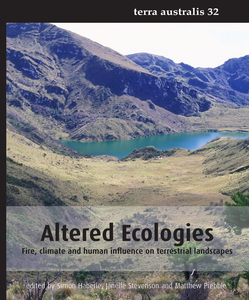Last Glacial Maximum habitat change and its effects on the grey-headed flying fox (Pteropus poliocephalus Temminck 1825)
Luly, J.G., Blair, David, Parsons, Jennifer G., Fox, Samantha, and VanDerWal, Jeremy (2010) Last Glacial Maximum habitat change and its effects on the grey-headed flying fox (Pteropus poliocephalus Temminck 1825). In: Haberle, Simon G., Stevenson, Janelle, and Prebble, Matthew, (eds.) Altered Ecologies: fire, climate and human influence on terrestrial landscapes. Terra Australis, 32 . ANU E Press, Canberra, ACT, Australia, pp. 83-100.
|
PDF (Published Version)
- Published Version
Restricted to Repository staff only |
||
![[img]](https://researchonline.jcu.edu.au/15103/2.hassmallThumbnailVersion/15103_Luly_et_al_2010_Book_Cover.jpg)
|
Image (JPEG) (Book Cover)
- Cover Image
Download (233kB) |
Abstract
The grey-headed flying fox (Pteropus poliocephalus) is a large phytophagous bat found in coastal and near-coastal eastern Australia, from Mackay in the north to Geelong in the south (Parsons et al. 2008; Roberts et al. 2008). It is among the best known of the Australian flying foxes. Eby (1991), Parry-Jones and Augee (1991, 1992, 2001), Tidemann and Nelson (2004), McDonald-Madden et al. (2005), Parris and Hazell (2005), and Williams et al. (2006) documented aspects of P. poliocephalus ecology. Eby (1991) and Parry-Jones and Augee (2001) focused on movements between colony sites and feeding areas, while Tidemann and Nelson (2004) demonstrated long-distance movements between colonies. Breeding biology was dealt with by Martin et al. (1985), O’Brien (1993), and Fox (2006), and conservation status was summarised by Dickman and Fleming (2002).
The application of molecular tools to flying-fox phylogeny and phylogeography is in its infancy but the approach has obvious potential to solve many of the intractable problems posed to traditional methodologies by this elusive nocturnal species. Among other uses, analyses of genetic diversity can indicate whether a species has undergone changes in population size. In this paper, we place the molecular evidence for population change into a palaeoenvironmental context to gauge the antiquity of any such change and assess its implications for understanding long-term flying-fox responses to contemporary habitat fragmentation and habitat change.
| Item ID: | 15103 |
|---|---|
| Item Type: | Book Chapter (Research - B1) |
| ISBN: | 978-1-921666-80-3 |
| Funders: | Department of Archaeology and Natural History (ANU) and the Australasian Quaternary Association |
| Date Deposited: | 09 Dec 2010 23:26 |
| FoR Codes: | 06 BIOLOGICAL SCIENCES > 0604 Genetics > 060411 Population, Ecological and Evolutionary Genetics @ 40% 04 EARTH SCIENCES > 0406 Physical Geography and Environmental Geoscience > 040606 Quaternary Environments @ 50% 05 ENVIRONMENTAL SCIENCES > 0502 Environmental Science and Management > 050211 Wildlife and Habitat Management @ 10% |
| SEO Codes: | 96 ENVIRONMENT > 9608 Flora, Fauna and Biodiversity > 960899 Flora, Fauna and Biodiversity of Environments not elsewhere classified @ 100% |
| Downloads: |
Total: 586 Last 12 Months: 6 |
| More Statistics |



